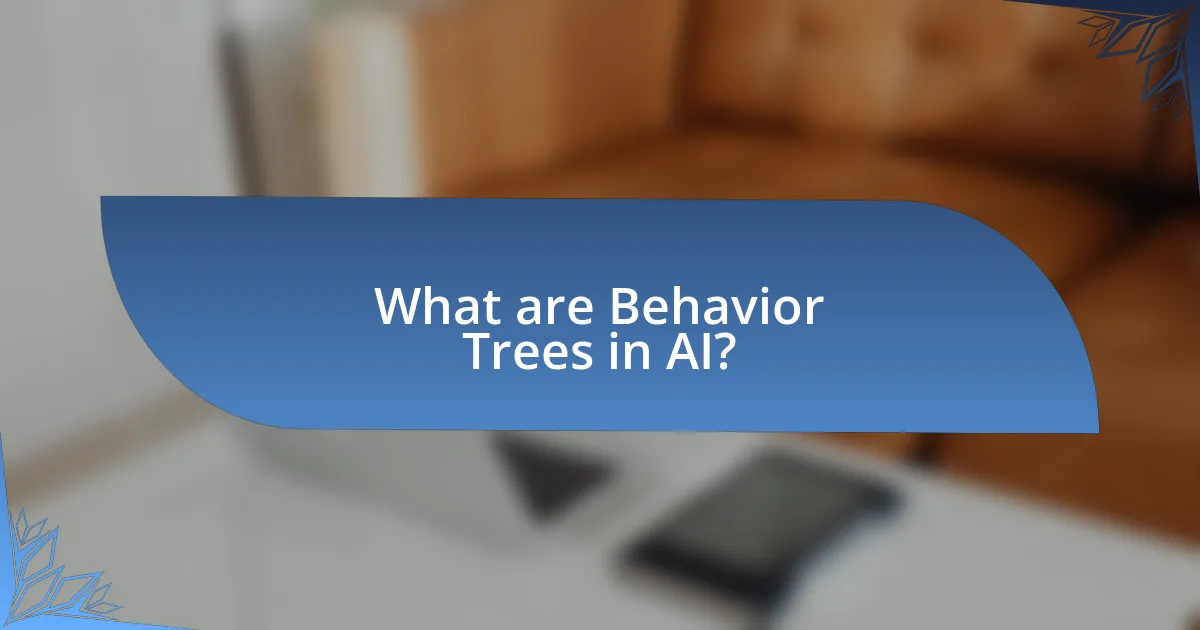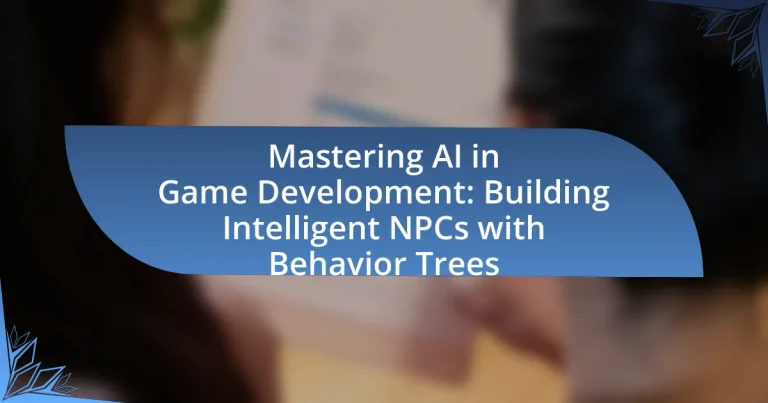The article focuses on the integration of artificial intelligence (AI) in game development, specifically through the use of behavior trees to create intelligent non-player characters (NPCs). It outlines how AI enhances gameplay experiences by enabling NPCs to exhibit realistic and adaptive behaviors, thereby increasing player immersion and engagement. Key components of AI, such as pathfinding, decision-making, and behavior modeling, are discussed, along with the roles NPCs play in storytelling and player interaction. The article also details the structure and implementation of behavior trees, their advantages over traditional AI models, and best practices for optimizing their use in game design.

What is AI in Game Development?
AI in game development refers to the use of algorithms and techniques to create intelligent behaviors in non-player characters (NPCs) and enhance gameplay experiences. This includes pathfinding, decision-making, and adaptive learning, allowing NPCs to respond dynamically to player actions. For instance, behavior trees are a common method used to structure NPC decision-making processes, enabling them to exhibit complex behaviors based on player interactions. The effectiveness of AI in games is evidenced by its ability to create immersive environments, as seen in popular titles like “The Last of Us” and “Halo,” where NPCs demonstrate realistic and engaging behaviors that enhance player engagement.
How does AI enhance gameplay experiences?
AI enhances gameplay experiences by creating more realistic and adaptive non-player characters (NPCs) that respond intelligently to player actions. This is achieved through behavior trees, which allow NPCs to exhibit complex decision-making processes, making interactions more engaging and dynamic. For instance, games like “The Last of Us” utilize AI-driven NPCs that adapt their strategies based on player behavior, resulting in a more immersive experience. Studies show that players report higher satisfaction levels when interacting with AI that demonstrates lifelike behaviors, as it increases the challenge and unpredictability of gameplay.
What are the key components of AI in games?
The key components of AI in games include pathfinding, decision-making, and behavior modeling. Pathfinding algorithms, such as A* or Dijkstra’s, enable characters to navigate complex environments efficiently. Decision-making frameworks, like finite state machines or behavior trees, allow NPCs to react dynamically to player actions and environmental changes. Behavior modeling incorporates techniques such as machine learning to create more realistic and adaptive NPC behaviors. These components work together to enhance gameplay by providing challenging and engaging interactions.
How do AI systems interact with game mechanics?
AI systems interact with game mechanics by utilizing algorithms to influence gameplay dynamics and player experiences. These systems analyze player actions and environmental variables to adapt behaviors, enabling non-player characters (NPCs) to respond intelligently within the game world. For instance, behavior trees are commonly employed to structure decision-making processes, allowing NPCs to execute complex actions based on specific triggers and conditions. This interaction enhances realism and engagement, as AI-driven characters can simulate human-like responses, making the game more immersive. Studies have shown that effective AI integration can significantly improve player satisfaction and retention rates, demonstrating the importance of AI in modern game design.
Why are Non-Player Characters (NPCs) important in games?
Non-Player Characters (NPCs) are important in games because they enhance player immersion and engagement by providing interactive elements that contribute to the game’s narrative and environment. NPCs serve various roles, such as quest givers, enemies, or allies, which enrich the gameplay experience and create a dynamic world. For instance, in role-playing games like “The Witcher 3,” NPCs offer quests and dialogue that shape the story, making players feel more connected to the game world. Their presence can also facilitate social interactions, as seen in multiplayer games where NPCs can act as intermediaries or provide context for player actions. Thus, NPCs are essential for creating a compelling and interactive gaming experience.
What roles do NPCs play in storytelling?
NPCs, or non-player characters, serve multiple critical roles in storytelling, primarily as facilitators of narrative progression, sources of conflict, and embodiments of thematic elements. They drive the plot forward by providing quests, information, or challenges that engage players and enhance the narrative experience. For instance, in role-playing games, NPCs often deliver essential backstory or context that enriches the player’s understanding of the game world. Additionally, NPCs can create conflict through their actions or decisions, influencing player choices and outcomes, which is vital for dynamic storytelling. Furthermore, they can represent various themes, such as morality, loyalty, or betrayal, allowing players to explore complex emotional landscapes. This multifaceted involvement of NPCs in storytelling is supported by their ability to interact with players in meaningful ways, making them integral to immersive game narratives.
How do NPCs contribute to player immersion?
NPCs contribute to player immersion by creating a dynamic and interactive environment that responds to player actions and decisions. Their behaviors, dialogue, and interactions can enhance the narrative and emotional engagement, making players feel as though they are part of a living world. For instance, NPCs that exhibit realistic reactions to player choices can deepen the sense of agency and consequence, which is crucial for immersion. Research indicates that players report higher levels of immersion when NPCs display complex behaviors and adaptive responses, as seen in games utilizing advanced AI techniques like behavior trees. This approach allows NPCs to react in ways that feel authentic, reinforcing the player’s connection to the game world.

What are Behavior Trees in AI?
Behavior Trees in AI are a hierarchical model used to design the behavior of agents, particularly in video games. They consist of nodes that represent tasks, conditions, and control flow, allowing for complex decision-making processes. Behavior Trees provide a structured way to manage the execution of behaviors, enabling non-player characters (NPCs) to react dynamically to their environment. This approach is validated by its widespread use in game development, as seen in titles like “Halo” and “The Last of Us,” where NPCs exhibit sophisticated behaviors through this framework.
How do Behavior Trees function in game AI?
Behavior Trees function in game AI by providing a structured framework for modeling the decision-making processes of non-player characters (NPCs). They consist of nodes that represent actions, conditions, and control flow, allowing NPCs to execute complex behaviors in a modular and hierarchical manner. Each node can be evaluated to determine whether to execute its associated action or transition to another node, enabling dynamic responses to changing game environments. This approach enhances the flexibility and scalability of AI behavior, as developers can easily add or modify behaviors without overhauling the entire system. The effectiveness of Behavior Trees is evidenced by their widespread adoption in commercial games, where they facilitate the creation of more lifelike and responsive NPCs.
What are the main components of a Behavior Tree?
The main components of a Behavior Tree are nodes, which include action nodes, condition nodes, and control nodes. Action nodes represent tasks that an agent can perform, condition nodes check for specific conditions to be met, and control nodes dictate the flow of execution based on the results of child nodes. These components work together to create a structured and modular approach to decision-making in AI, allowing for complex behaviors to be built from simple, reusable elements.
How do Behavior Trees differ from other AI models?
Behavior Trees differ from other AI models primarily in their hierarchical structure and modularity, which allows for more flexible and manageable decision-making processes. Unlike traditional finite state machines that can become complex and difficult to manage as the number of states increases, Behavior Trees break down behaviors into smaller, reusable components, enabling easier debugging and modification. This modular approach facilitates the creation of complex behaviors by combining simple tasks, which is particularly beneficial in game development where NPCs require dynamic and adaptable actions. Additionally, Behavior Trees provide a clear visual representation of behavior sequences, enhancing the understanding of AI logic compared to other models that may lack such clarity.
Why are Behavior Trees preferred for NPC development?
Behavior Trees are preferred for NPC development because they provide a clear and modular structure for defining complex behaviors. This modularity allows developers to easily create, modify, and reuse behavior components, leading to more efficient development processes. Additionally, Behavior Trees facilitate better debugging and visualization of NPC actions, as they represent decision-making in a hierarchical manner. This approach enhances the scalability of NPC behaviors, making it easier to manage and expand as game requirements evolve. The effectiveness of Behavior Trees in game AI has been demonstrated in various successful titles, such as “Halo” and “The Last of Us,” where they contributed to more dynamic and responsive NPC interactions.
What advantages do Behavior Trees offer over traditional methods?
Behavior Trees provide several advantages over traditional methods in AI development for games, primarily through their modularity, reusability, and ease of debugging. Modularity allows developers to create complex behaviors by combining simpler tasks, making it easier to manage and modify AI logic. This contrasts with traditional finite state machines, which can become unwieldy as complexity increases. Additionally, Behavior Trees enable the reuse of behavior components across different characters or scenarios, enhancing efficiency in development. Their hierarchical structure also simplifies debugging, as developers can easily visualize and trace the execution flow, identifying issues more quickly than in traditional methods. These characteristics contribute to more scalable and maintainable AI systems in game development.
How do Behavior Trees improve NPC decision-making?
Behavior Trees enhance NPC decision-making by providing a structured and modular approach to behavior management. This framework allows NPCs to evaluate conditions and execute actions in a hierarchical manner, enabling more dynamic and responsive interactions within the game environment. For instance, Behavior Trees facilitate the prioritization of tasks based on changing circumstances, which leads to more realistic and engaging NPC behavior. Research indicates that this method improves the scalability and maintainability of AI systems, as developers can easily modify or extend behaviors without overhauling the entire decision-making process.

How to implement Behavior Trees for NPCs?
To implement Behavior Trees for NPCs, first, define the structure of the Behavior Tree, which consists of nodes representing actions, conditions, and control flow. Each node can be categorized as a composite node (like Selector or Sequence), a decorator node, or a leaf node (action or condition). Next, create a system to evaluate these nodes, where the tree is traversed from the root to the leaves, executing actions or checking conditions based on the node type.
For example, a Selector node will execute its children until one succeeds, while a Sequence node will execute its children in order until one fails. This structure allows for modular and reusable behaviors, making it easier to manage complex NPC actions.
The validity of this approach is supported by its widespread use in game development, as seen in popular games like “Halo” and “The Last of Us,” where Behavior Trees facilitate dynamic and responsive NPC behaviors.
What are the steps to create a Behavior Tree?
To create a Behavior Tree, follow these steps: first, define the behavior you want to model, identifying the goals and tasks of the non-player character (NPC). Next, break down the behavior into smaller, manageable tasks or actions, which will serve as the nodes of the tree. Then, organize these nodes hierarchically, using control flow nodes such as selectors and sequences to dictate the order of execution. After structuring the tree, implement the logic for each node, ensuring that they can execute the defined actions and return success or failure statuses. Finally, test the Behavior Tree in the game environment, iterating on the design based on observed performance and desired outcomes. This structured approach is validated by the widespread use of Behavior Trees in game development, as they provide a clear framework for managing complex NPC behaviors efficiently.
How do you define tasks and conditions in a Behavior Tree?
Tasks in a Behavior Tree are defined as the actions that an NPC (non-player character) can perform, while conditions are defined as the checks that determine whether a task can be executed. Tasks represent specific behaviors, such as moving to a location or attacking an enemy, and are typically implemented as leaf nodes in the tree structure. Conditions, on the other hand, are used to evaluate the current state of the game or the NPC, such as checking if the NPC’s health is below a certain threshold or if an enemy is within range. This structure allows for a modular and hierarchical approach to decision-making, enabling complex behaviors to be constructed from simpler tasks and conditions.
What tools can assist in building Behavior Trees?
Tools that can assist in building Behavior Trees include Unreal Engine’s Behavior Tree Editor, Unity’s Behavior Designer, and NodeCanvas. Unreal Engine’s Behavior Tree Editor provides a visual interface for creating complex AI behaviors, allowing developers to design and debug behavior trees directly within the engine. Unity’s Behavior Designer offers a similar visual scripting environment, enabling the integration of behavior trees into Unity projects with ease. NodeCanvas, also for Unity, combines behavior trees with state machines, providing flexibility in AI design. These tools are widely used in the game development industry, demonstrating their effectiveness in creating intelligent NPCs.
What common challenges arise when using Behavior Trees?
Common challenges when using Behavior Trees include complexity in design, difficulty in debugging, and performance issues. The complexity arises from the need to balance multiple behaviors and states, which can lead to intricate tree structures that are hard to manage. Debugging becomes challenging due to the non-linear execution flow of Behavior Trees, making it difficult to trace the source of issues. Performance issues can occur when trees become too large or when frequent updates are required, potentially leading to inefficiencies in resource usage. These challenges are documented in various studies, highlighting the need for careful design and optimization strategies in implementing Behavior Trees for AI in game development.
How can you troubleshoot issues in Behavior Tree implementation?
To troubleshoot issues in Behavior Tree implementation, first, verify the structure and logic of the tree to ensure that nodes are correctly connected and configured. This involves checking for proper parent-child relationships and ensuring that conditions and actions are accurately defined. Additionally, utilize debugging tools or logging to track the execution flow of the Behavior Tree, which can help identify where the logic fails or behaves unexpectedly. For instance, if a node is not being executed, logging can reveal whether the conditions for that node are being met. Furthermore, reviewing the implementation against established Behavior Tree design patterns can provide insights into potential misconfigurations.
What are best practices for optimizing Behavior Trees?
Best practices for optimizing Behavior Trees include minimizing the number of nodes, using decorators effectively, and caching results. Reducing the number of nodes decreases the computational overhead, allowing for faster evaluations. Effective use of decorators can streamline decision-making processes by adding conditions without cluttering the tree structure. Caching results from expensive computations prevents redundant calculations, enhancing performance. These practices are supported by performance benchmarks in game development, which demonstrate that optimized Behavior Trees can significantly improve the responsiveness and efficiency of NPC behaviors.
What are some practical tips for mastering AI in game development?
To master AI in game development, focus on understanding behavior trees, which provide a structured way to create complex NPC behaviors. Start by learning the fundamentals of behavior trees, including nodes, decorators, and sequences, as they allow for modular and reusable AI logic. Implement simple behaviors first, such as patrolling or chasing, and gradually increase complexity by adding conditions and actions. Utilize tools like Unity or Unreal Engine, which offer built-in support for behavior trees, to streamline your development process. Additionally, study existing games to analyze their AI systems, which can provide insights into effective design patterns and techniques. Engaging with communities and forums dedicated to game AI can also enhance your learning through shared experiences and resources.


